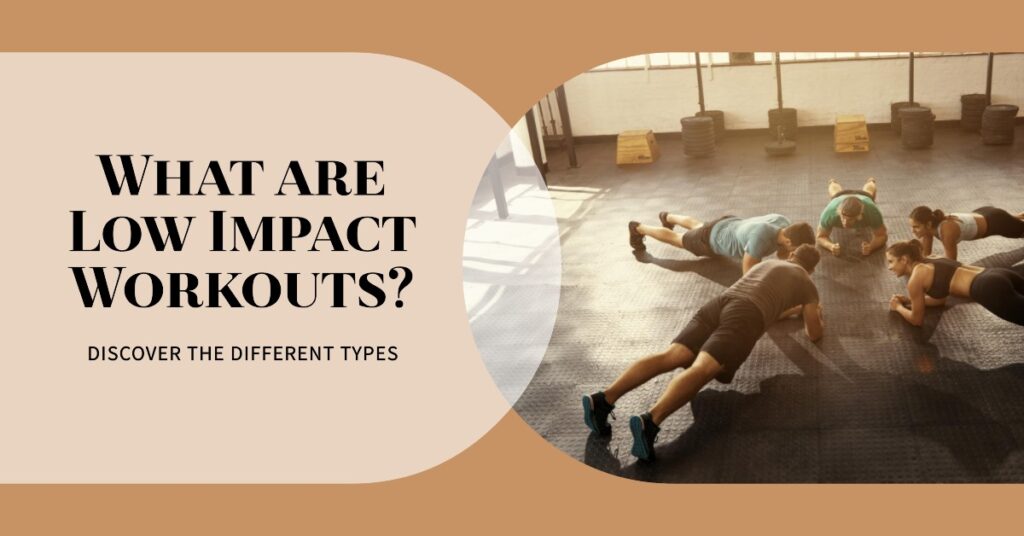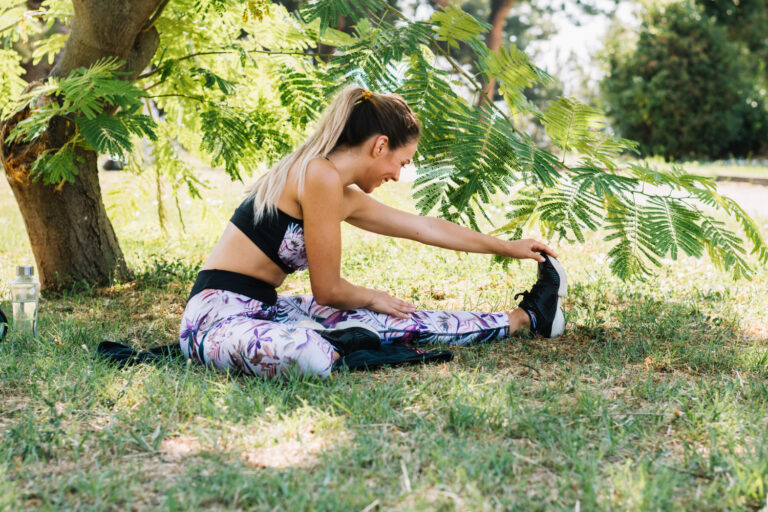In a world that often glorifies high-intensity, heart-pounding workouts, the concept of low-impact fitness emerges as a gentle yet transformative alternative.
Why not? The traditional narrative of fitness can be intimidating, particularly for those with joint concerns, recovering from injuries, or simply seeking a more sustainable approach.
Enter the realm of low-impact workouts – a realm where exercise becomes not just a means of burning calories, but a holistic journey toward enhancing both physical and mental health.
In this exploration, we’ll unravel the intricacies of low-impact exercises, shedding light on their diverse benefits and providing you with a roadmap to a healthier, more enjoyable fitness journey.
Page Contents
What are Low Impact Workouts and The Different Types of It?

Low-impact workouts encompass a variety of exercises designed to minimize stress on the joints and reduce the risk of injury, making them ideal for individuals of all fitness levels. The defining feature of low-impact exercises is that they keep one foot or body in contact with the ground, avoiding forceful, jarring movements, and providing effective cardiovascular, strength, and flexibility benefits.
Let’s take a look at some of the common low-impact exercises to better understand the topic.
Walking:
Walking is a fundamental and accessible low-impact exercise that can be incorporated into daily life. It is an excellent cardiovascular workout that engages major muscle groups, promotes joint flexibility, and boosts overall stamina. Whether you choose a leisurely stroll or a brisk walk, the simplicity of walking makes it a versatile option for people of all ages and fitness levels.
Cycling:
Cycling, either outdoors or on a stationary bike, offers a smooth and continuous motion that is easy on the joints. It targets the muscles in the legs, particularly the quadriceps, and hamstrings, while providing an effective cardiovascular workout. Cycling can be a recreational activity, a means of transportation, or a focused workout, making it adaptable to various lifestyles.
If you are a working professional, you can go with indoor cycling to exercise at your home comfort. Check out our list of top indoor bikes for optimum results.
Swimming:
Swimming is a full-body workout that is particularly gentle on the joints due to the buoyancy provided by water. It engages muscles in the arms, legs, and core, enhancing strength and endurance. Swimming is not only an effective exercise but also a refreshing and therapeutic activity, making it suitable for individuals with arthritis, back pain, or other joint-related concerns.
Yoga and Pilates:
Yoga and Pilates focus on controlled movements, balance, flexibility, and core strength. Yoga, with its various styles such as Hatha, Vinyasa, or Yin, emphasizes breath awareness and mindfulness. Pilates, on the other hand, concentrates on core stability and controlled movements. Both practices enhance flexibility, improve posture, and provide a holistic mind-body experience.
Bodyweight Exercises:
Bodyweight exercises involve using your own body as resistance for strength training. Squats, lunges, push-ups, and planks are examples of bodyweight exercises that target different muscle groups. These exercises help build strength, improve muscle tone, and enhance overall body awareness without the need for external equipment.
Now, let’s move on to the benefits of adopting a low-impact exercise, and then we will talk about how you can start your journey.
Benefits of Low-Impact Workouts: Why Should You Adopt?

Joint Health:
Low-impact exercises prioritize joint health by minimizing stress and impact. This is particularly advantageous for individuals with conditions like arthritis or those in post-rehabilitation. The controlled movements help preserve joint integrity over time, allowing for sustained physical activity without exacerbating joint discomfort.
Reduced Injury Risk:
Low-impact workouts significantly reduce the risk of common exercise-related injuries. The controlled nature of these exercises minimizes the impact on bones and joints, making them safer for individuals prone to injuries or those recovering from previous incidents. This risk reduction factor promotes long-term, injury-free participation in physical activities.
Sustainability:
Sustainability is a key feature of low-impact exercises. The reduced risk of injury and joint strain allows individuals to maintain consistent workout routines over the long term. This consistency is crucial for overall health benefits, weight management, and the establishment of a sustainable and enjoyable fitness routine.
Adaptability:
Low-impact workouts are highly adaptable to various fitness levels and age groups. Whether you’re just starting your fitness journey, dealing with specific health concerns, or aiming to maintain fitness as you age, these exercises offer the flexibility to customize intensity and duration. This adaptability ensures inclusivity and long-term engagement.
Cardiovascular Health:
Despite being low-impact, many of these exercises provide significant cardiovascular benefits. Activities like walking, cycling, and swimming elevate the heart rate, improve circulation and contribute to overall cardiovascular health. This is essential for reducing the risk of heart disease, maintaining a healthy weight, and enhancing endurance.
Improved Flexibility and Strength:
Yoga, Pilates, and bodyweight exercises specifically target flexibility and strength. These workouts improve muscle flexibility, joint range of motion, and core strength. Enhanced flexibility reduces the risk of injuries, while improved strength contributes to better posture, stability, and overall functional fitness.
Mind-Body Connection:
Practices like yoga and Pilates go beyond physical fitness to nurture a strong mind-body connection. Incorporating mindfulness, deep breathing, and relaxation techniques into these exercises promotes mental well-being, stress reduction, and an overall sense of balance. This holistic approach supports both physical and mental health.
Now, let’s explore some practical tips for getting started with low-impact exercises, considering factors like consultation with healthcare professionals, gradual progression, and seamless integration into daily life.
Getting Started with Your Low-Impact Workout Journey

Consultation:
Before embarking on any fitness journey, it’s essential to consult with a healthcare professional, especially if you have pre-existing health conditions or concerns. This step ensures that your chosen low-impact exercises align with your individual health needs and minimize the risk of potential complications. A healthcare provider can offer personalized advice, taking into account your medical history and any specific considerations.
Gradual Progression:
The mantra for success in low-impact fitness is gradual progression. Whether you’re new to exercise or returning after a hiatus, starting slowly allows your body to adapt and build strength without unnecessary strain. Begin with shorter durations and lower intensity, gradually increasing as your fitness level improves. This incremental approach not only reduces the risk of injury but also fosters a sustainable fitness habit.
Incorporating into Daily Life:
The beauty of low-impact exercises lies in their seamless integration into daily life. From opting for stairs instead of elevators to incorporating short walks during breaks, small changes can yield significant health benefits. Designing a fitness routine that aligns with your lifestyle enhances adherence, making it more likely that you’ll stay committed to your health goals. Finding joy in these activities transforms them from mere workouts into enjoyable daily rituals.
Motivation and Consistency:
Goal-setting is a powerful motivator, but it’s crucial to set realistic and achievable objectives. Whether you aim to increase daily step counts, master a new yoga pose, or complete a cycling route, small victories contribute to long-term success. Realistic goals ensure a sense of accomplishment, boosting motivation and reinforcing the habit of regular physical activity.
Variety:
Monotony can be a significant barrier to maintaining a consistent fitness routine. Low-impact exercises offer a diverse range of options, allowing you to incorporate variety into your workouts. Alternate between walking, cycling, swimming, and other activities to keep both your body and mind engaged. Exploring different low-impact exercises not only prevents boredom but also targets various muscle groups for comprehensive fitness.
Accountability:
Consider enlisting the support of a workout buddy, joining a fitness class, or using fitness apps to enhance accountability. Having a partner or a community to share your fitness journey with can provide motivation, encouragement, and a sense of camaraderie. Technology, through fitness trackers and apps, can help you track progress, set reminders, and stay on course, reinforcing the habit of regular low-impact exercise.
Final Words
In the realm of fitness, where high-intensity workouts often steal the spotlight, the gentle power of low-impact exercises emerges as a transformative force.
Throughout this exploration, we’ve uncovered the diverse array of benefits that these activities bring to the table, from preserving joint health to fostering sustainability and consistency in our fitness routines.
As we conclude our journey through the world of low-impact fitness, it’s crucial to reflect on the pivotal role these exercises play in redefining our approach to staying fit. The inclusivity of low-impact workouts opens the doors to fitness for individuals of all ages and fitness levels.
It’s not about pushing our bodies to extremes but rather about embracing activities that contribute to our well-being sustainably and enjoyably.

Daniel Amankwah is a fitness expert for 4EvaFit Lifestyle, personal fitness coach, personal trainer, blogger, and a motivational speaker living in Acton, Massachusetts. His affection for a healthy lifestyle has penetrated through the noise in the health, fitness industry and empowers people to create sustainable prescriptions for lasting health, happiness, and confidence.
A background as a business researcher coupled with a personal passion for fitness help brings our readership a thoughtful curation fitness guide and fitness product review. His burning desire is to share his fitness experience and offer some encouragement to anyone that is working to better themselves physically through healthy eating habits and being active.
As a visionary, his vision is a world where daily acts of self-love and care are a regular part of life.







![Best Workout Equipment For Women Home Exercise [2022 Updated] 52 Best Workout Equipment For Women Home Exercise [2022 Updated]](https://4evafit.com/wp-content/uploads/2020/02/Best-Women-Workout-Equipment-For-Home-under-budget-768x320.jpg)
